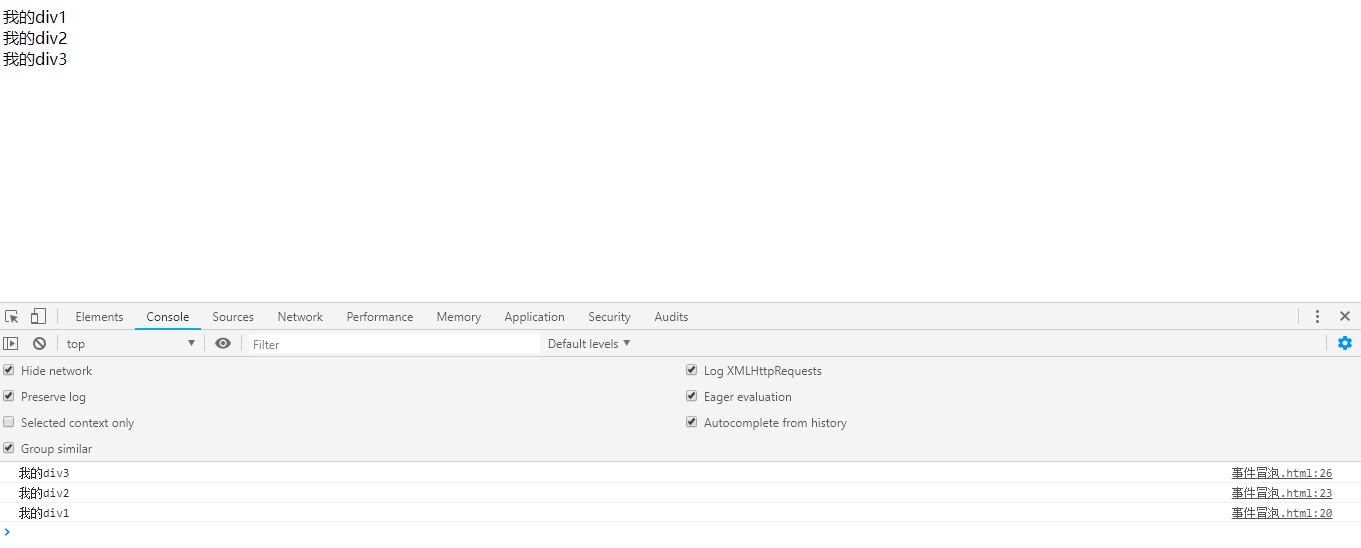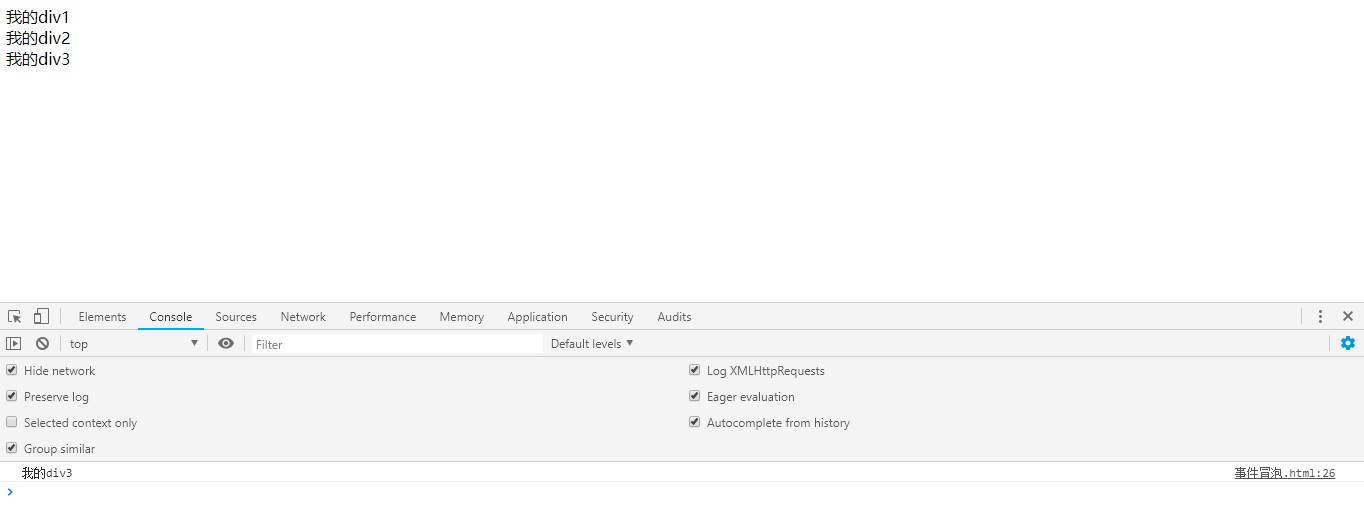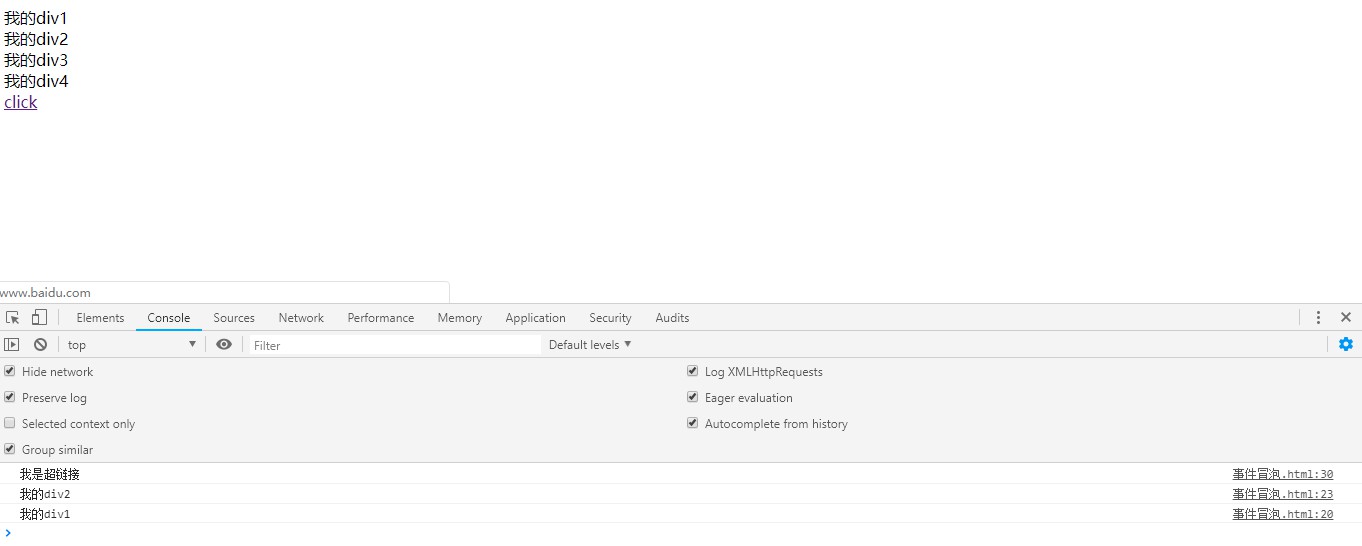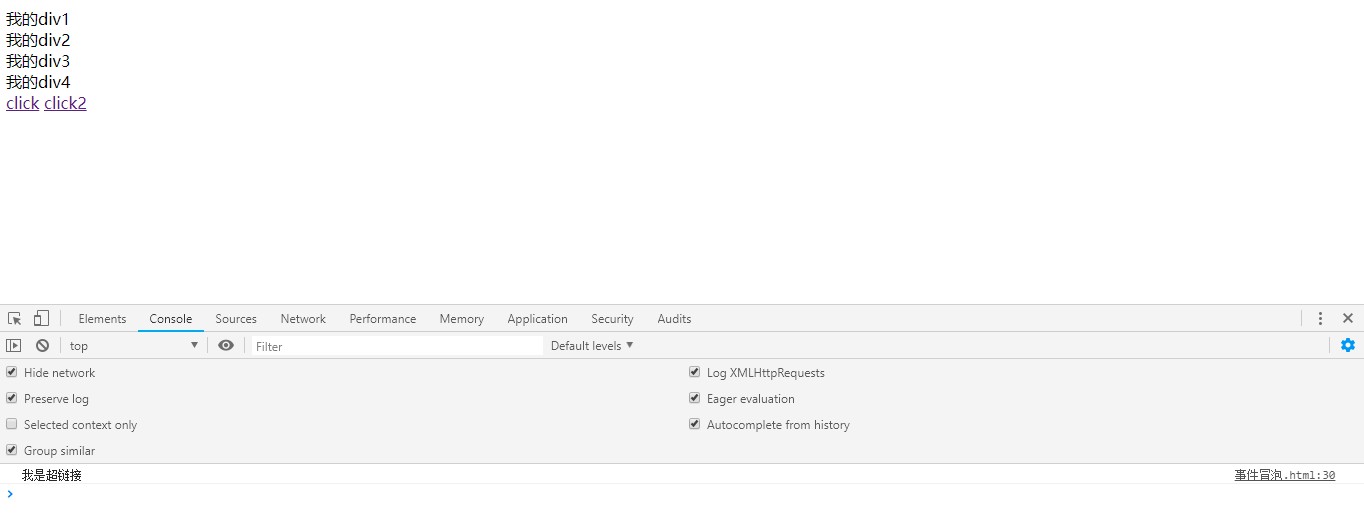本文小编为大家详细介绍“Vue中的event对象怎么用”,内容详细,步骤清晰,细节处理妥当,希望这篇“Vue中的event对象怎么用”文章能帮助大家解决疑惑,下面跟着小编的思路慢慢深入,一起来学习新知识吧。
event对象:代表的是事件的状态。比如获取当前的元素:e.Target。
什么是事件冒泡呢?百度百科的解释如下:
当事件发生后,这个事件就要开始传播(从里到外或者从外向里)。为什么要传播呢?因为事件源本身(可能)并没有处理事件的能力,即处理事件的函数(方法)并未绑定在该事件源上。例如我们点击一个按钮时,就会产生一个click事件,但这个按钮本身可能不能处理这个事件,事件必须从这个按钮传播出去,从而到达能够处理这个事件的代码中(例如我们给按钮的onclick属性赋一个函数的名字,就是让这个函数去处理该按钮的click事件),或者按钮的父级绑定有事件函数,当该点击事件发生在按钮上,按钮本身并无处理事件函数,则传播到父级去处理。
可能下面的例子会更容易理解一些:
<!DOCTYPE html>
<html lang="en">
<head>
<meta charset="UTF-8">
<meta name="viewport" content="width=device-width, initial-scale=1.0">
<meta http-equiv="X-UA-Compatible" content="ie=edge">
<title>事件冒泡</title>
<!--引入vue.js-->
<script src="node_modules/vue/dist/vue.js" ></script>
<script>
window.onload=function(){
// 构建vue实例
new Vue({
el:"#my",
data:{
},
// 方法
methods:{
play1:function(){
console.log("我的div1");
},
play2:function(){
console.log("我的div2");
},
play3:function(){
console.log("我的div3");
}
}
})
}
</script>
</head>
<body>
<div id="my">
<div @click="play1">我的div1
<div @click="play2">我的div2
<div @click="play3">
我的div3
</div>
</div>
</div>
</div>
</body>
</html>效果:

在上面的代码中,3个div分别绑定了3个不同的事件,点击"我的div3"的时候
那么该如何阻止事件冒泡呢?
代码示例如下:
<!DOCTYPE html>
<html lang="en">
<head>
<meta charset="UTF-8">
<meta name="viewport" content="width=device-width, initial-scale=1.0">
<meta http-equiv="X-UA-Compatible" content="ie=edge">
<title>事件冒泡</title>
<!--引入vue.js-->
<script src="node_modules/vue/dist/vue.js" ></script>
<script>
window.onload=function(){
// 构建vue实例
new Vue({
el:"#my",
data:{
},
// 方法
methods:{
play1:function(){
console.log("我的div1");
},
play2:function(){
console.log("我的div2");
},
play3:function(e){
console.log("我的div3");
e.stopPropagation();
}
}
})
}
</script>
</head>
<body>
<div id="my">
<div @click="play1">我的div1
<div @click="play2">我的div2
<div @click="play3($event)">
我的div3
</div>
</div>
</div>
</div>
</body>
</html>效果:

代码示例如下:
<!DOCTYPE html>
<html lang="en">
<head>
<meta charset="UTF-8">
<meta name="viewport" content="width=device-width, initial-scale=1.0">
<meta http-equiv="X-UA-Compatible" content="ie=edge">
<title>事件冒泡</title>
<!--引入vue.js-->
<script src="node_modules/vue/dist/vue.js" ></script>
<script>
window.onload=function(){
// 构建vue实例
new Vue({
el:"#my",
data:{
},
// 方法
methods:{
play1:function(){
console.log("我的div1");
},
play2:function(){
console.log("我的div2");
},
play3:function(e){
console.log("我的div3");
//e.stopPropagation();
}
}
})
}
</script>
</head>
<body>
<div id="my">
<div @click="play1">我的div1
<div @click="play2">我的div2
<div @click="play3($event)">
我的div3
</div>
<!--Vue中使用事件修饰符阻止冒泡-->
<div @click.stop="play3($event)">
我的div4
</div>
</div>
</div>
</div>
</body>
</html>效果:

点击"我的div4"的时候会阻止事件冒泡,但点击"我的div3"的时候不会阻止事件冒泡。
看下面的代码示例:
<!DOCTYPE html>
<html lang="en">
<head>
<meta charset="UTF-8">
<meta name="viewport" content="width=device-width, initial-scale=1.0">
<meta http-equiv="X-UA-Compatible" content="ie=edge">
<title>事件冒泡</title>
<!--引入vue.js-->
<script src="node_modules/vue/dist/vue.js" ></script>
<script>
window.onload=function(){
// 构建vue实例
new Vue({
el:"#my",
data:{
},
// 方法
methods:{
play1:function(){
console.log("我的div1");
},
play2:function(){
console.log("我的div2");
},
play3:function(e){
console.log("我的div3");
//e.stopPropagation();
},
play4:function(e){
console.log("我是超链接");
}
}
})
}
</script>
</head>
<body>
<div id="my">
<div @click="play1">我的div1
<div @click="play2">我的div2
<div @click="play3($event)">
我的div3
</div>
<!--Vue中使用事件修饰符阻止冒泡-->
<div @click.stop="play3($event)">
我的div4
</div>
<a href="http://www.baidu.com" rel="external nofollow" rel="external nofollow" rel="external nofollow" rel="external nofollow" @click="play4($event)">click</a>
</div>
</div>
</div>
</body>
</html>效果:
点击“click”的时候会发现页面跳转到了百度,不会进入play4事件,如果调试代码想进入play4事件该如何处理呢?
代码示例如下:
<!DOCTYPE html>
<html lang="en">
<head>
<meta charset="UTF-8">
<meta name="viewport" content="width=device-width, initial-scale=1.0">
<meta http-equiv="X-UA-Compatible" content="ie=edge">
<title>事件冒泡</title>
<!--引入vue.js-->
<script src="node_modules/vue/dist/vue.js" ></script>
<script>
window.onload=function(){
// 构建vue实例
new Vue({
el:"#my",
data:{
},
// 方法
methods:{
play1:function(){
console.log("我的div1");
},
play2:function(){
console.log("我的div2");
},
play3:function(e){
console.log("我的div3");
//e.stopPropagation();
},
play4:function(e){
console.log("我是超链接");
// 取消事件的默认动作
e.preventDefault();
}
}
})
}
</script>
</head>
<body>
<div id="my">
<div @click="play1">我的div1
<div @click="play2">我的div2
<div @click="play3($event)">
我的div3
</div>
<!--Vue中使用事件修饰符阻止冒泡-->
<div @click.stop="play3($event)">
我的div4
</div>
<a href="http://www.baidu.com" rel="external nofollow" rel="external nofollow" rel="external nofollow" rel="external nofollow" @click="play4($event)">click</a>
</div>
</div>
</div>
</body>
</html>效果:

这里在点击“click”的时候就不会进入百度首页了。这里没有处理冒泡,所以会触发play2和play1事件。
代码示例如下:
<!DOCTYPE html>
<html lang="en">
<head>
<meta charset="UTF-8">
<meta name="viewport" content="width=device-width, initial-scale=1.0">
<meta http-equiv="X-UA-Compatible" content="ie=edge">
<title>事件冒泡</title>
<!--引入vue.js-->
<script src="node_modules/vue/dist/vue.js" ></script>
<script>
window.onload=function(){
// 构建vue实例
new Vue({
el:"#my",
data:{
},
// 方法
methods:{
play1:function(){
console.log("我的div1");
},
play2:function(){
console.log("我的div2");
},
play3:function(e){
console.log("我的div3");
//e.stopPropagation();
},
play4:function(e){
console.log("我是超链接");
// 取消事件的默认动作
//e.preventDefault();
}
}
})
}
</script>
</head>
<body>
<div id="my">
<div @click="play1">我的div1
<div @click="play2">我的div2
<div @click="play3($event)">
我的div3
</div>
<!--Vue中使用事件修饰符阻止冒泡-->
<div @click.stop="play3($event)">
我的div4
</div>
<a href="http://www.baidu.com" rel="external nofollow" rel="external nofollow" rel="external nofollow" rel="external nofollow" @click="play4($event)">click</a>
<!--使用vue处理-->
<a href="http://www.baidu.com" rel="external nofollow" rel="external nofollow" rel="external nofollow" rel="external nofollow" @click.prevent.stop="play4($event)">click2</a>
</div>
</div>
</div>
</body>
</html>效果:

读到这里,这篇“Vue中的event对象怎么用”文章已经介绍完毕,想要掌握这篇文章的知识点还需要大家自己动手实践使用过才能领会,如果想了解更多相关内容的文章,欢迎关注亿速云行业资讯频道。
免责声明:本站发布的内容(图片、视频和文字)以原创、转载和分享为主,文章观点不代表本网站立场,如果涉及侵权请联系站长邮箱:is@yisu.com进行举报,并提供相关证据,一经查实,将立刻删除涉嫌侵权内容。